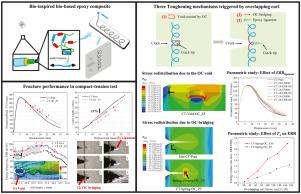Bio-inspired overlapping curl structures for toughening bio-based epoxy: A study on the fracture phenomena
IF 9.8
1区 材料科学
Q1 MATERIALS SCIENCE, COMPOSITES
引用次数: 0
Abstract
In this study, a 3D-printed biomimetic overlapping curl structure inspired by spider silk molecular structure, containing sacrificial bonds and hidden lengths, is studied as a toughening mechanism for a bio-based epoxy. Experimental results of the fracture phenomena of the overlapping curl-reinforced bio-based epoxy identify three toughening mechanisms triggered by the overlapping curl: (1) crack re-initiation, (2) overlapping curl bridging, and (3) epoxy ligament. First, the integrated overlapping curl creates a void within the epoxy matrix. As the crack tip reaches the end of this void, the crack re-initiates. Then, as the hidden length of overlapping curl unfolds, it leads to a bridging effect in resisting crack growth. In addition, for the smallest hidden length, an epoxy ligament is formed due to crack branching, significantly improving the energy release rate. The epoxy fracture energy release rate increased by 13 %. The overall modest improvement is attributed to the large plastic dissipation energy of the epoxy and the relatively low overlapping curl load-capacity. However, when expanding the design space numerically, it was shown that as the failure load of the overlapping curl increases, the bridging effect increases progressively. The introduction of the bio-inspired overlapping curl structure into bio-based epoxy proves the concept of a toughening strategy for developing high-performance sustainable composite materials.

生物基环氧树脂增韧的仿生重叠卷曲结构:断裂现象研究
在这项研究中,受蜘蛛丝分子结构的启发,3d打印仿生重叠卷曲结构,包含牺牲键和隐藏长度,研究了生物基环氧树脂的增韧机制。通过对重叠旋度增强生物基环氧树脂断裂现象的实验研究,确定了重叠旋度触发的三种增韧机制:(1)裂纹再萌生,(2)重叠旋度桥接,(3)环氧韧带。首先,集成的重叠卷曲在环氧树脂基体中产生空隙。当裂纹尖端到达空洞的末端时,裂纹重新开始。然后,随着重叠卷曲的隐藏长度展开,它在抵抗裂纹扩展中起到桥接作用。此外,在最小的隐藏长度下,由于裂纹分支形成环氧韧带,显著提高了能量释放率。环氧树脂断裂能释放率提高13%。整体的适度改善是由于环氧树脂的塑性耗散能大,而重叠旋度荷载能力相对较低。然而,当数值扩展设计空间时,表明随着重叠旋度破坏载荷的增大,桥接效应逐渐增大。将仿生重叠卷曲结构引入生物基环氧树脂中,证明了开发高性能可持续复合材料的增韧策略的概念。
本文章由计算机程序翻译,如有差异,请以英文原文为准。
求助全文
约1分钟内获得全文
求助全文
来源期刊

Composites Science and Technology
工程技术-材料科学:复合
CiteScore
16.20
自引率
9.90%
发文量
611
审稿时长
33 days
期刊介绍:
Composites Science and Technology publishes refereed original articles on the fundamental and applied science of engineering composites. The focus of this journal is on polymeric matrix composites with reinforcements/fillers ranging from nano- to macro-scale. CSTE encourages manuscripts reporting unique, innovative contributions to the physics, chemistry, materials science and applied mechanics aspects of advanced composites.
Besides traditional fiber reinforced composites, novel composites with significant potential for engineering applications are encouraged.
 求助内容:
求助内容: 应助结果提醒方式:
应助结果提醒方式:


